Rune: Difference between revisions
| Line 218: | Line 218: | ||
== Elder Futhark == |
== Elder Futhark == |
||
[[Image:Inscription on Golden horn of Gallehus.jpg|thumb|right|Detail of the Elder Futhark inscription on one of the 5th century AD[[Golden Horns of Gallehus]] found in Denmark.]] |
[[Image:Inscription on Golden horn of Gallehus.jpg|thumb|right|Detail of the Elder Futhark inscription on one of the 5th century AD [[Golden Horns of Gallehus]] found in Denmark.]] |
||
[[Image:Kyrkklocka från Saleby i Västergötland med runinskrift från 1228 (ur Sverige Runinskrifter).png|right|thumb|A church bell from Saleby, [[Västergötland]], Sweden, containing a runic inscription from 1228.]] |
[[Image:Kyrkklocka från Saleby i Västergötland med runinskrift från 1228 (ur Sverige Runinskrifter).png|right|thumb|A church bell from Saleby, [[Västergötland]], Sweden, containing a runic inscription from 1228.]] |
||
[[Image:Sigurd.svg|right|thumb|While also featuring a runic inscription detailing the erection of a bridge for a loved one, the 11th century [[Sigurd_stones#S.C3.B6_101|Ramsung carving]] is a [[Sigurd stones|Sigurd stone]] that depicts the legend of [[Sigurd]].]] |
[[Image:Sigurd.svg|right|thumb|While also featuring a runic inscription detailing the erection of a bridge for a loved one, the 11th century [[Sigurd_stones#S.C3.B6_101|Ramsung carving]] is a [[Sigurd stones|Sigurd stone]] that depicts the legend of [[Sigurd]].]] |
||
Revision as of 10:48, 12 December 2008
| Runic | |
|---|---|
| Script type | Alphabet
|
Time period | Elder Futhark from the 2nd century AD. |
| Direction | Left-to-right, boustrophedon |
| Languages | Germanic languages |
| Related scripts | |
Parent systems | |
Child systems | Younger Futhark, Anglo-Saxon futhorc |
Sister systems | Latin alphabet |
| ISO 15924 | |
| ISO 15924 | Runr (211), Runic |
| Unicode | |
Unicode alias | Runic |
The runic alphabets are a set of related alphabets using letters known as runes to write various Germanic languages prior to the adoption of the Latin alphabet and for specialized purposes thereafter. The Scandinavian variants are also known as futhark (or fuþark, derived from their first six letters of the alphabet: F, U, Þ, A, R, and K); the Anglo-Saxon variant as futhorc (due to sound changes undergone in Old English by the same six letters).
The earliest runic inscriptions date from around 150 AD, and the alphabet was generally replaced by the Latin alphabet with Christianization by around 700 AD in central Europe and by around 1100 AD in Scandinavia; however, the use of runes persisted for specialized purposes in Scandinavia, longest in rural Sweden until the early twentieth century (used mainly for decoration as runes in Dalarna and on Runic calendars).
The three best-known runic alphabets are the Elder Futhark (around 150 to 800 AD), the Anglo-Saxon runes (400 to 1100 AD), and the Younger Futhark (800–1100). The Younger Futhark is further divided into the long-branch runes (also called Danish, although they were also used in Norway and Sweden), short-twig or Rök runes (also called Swedish-Norwegian, although they were also used in Denmark), and the Hälsinge runes (staveless runes). The Younger Futhark developed further into the Marcomannic runes, the Medieval runes (1100 AD to 1500 AD), and the Dalecarlian runes (around 1500 to 1800 AD).
The origins of the runic alphabet are uncertain. Many characters of the Elder Futhark bear a close resemblance to characters from the Latin alphabet. Other candidates are the 5th to 1st century BC Northern Italic alphabets: Lepontic, Rhaetic and Venetic, all of which are closely related to each other and descend from the Old Italic alphabet.
Background
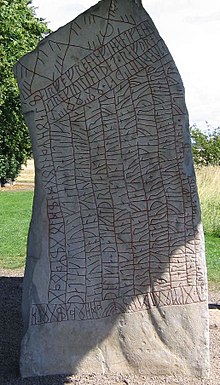
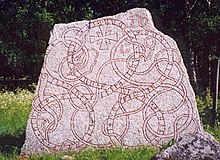
The runes were introduced to the Germanic peoples in the 1st or 2nd century AD. (The oldest known runic inscription dates to around 150 AD and is found on a comb discovered in the bog of Vimose, Funen, Denmark.[1] The inscription reads harja; a disputed candidate for a 1st century inscription is on the Meldorf fibula in southern Jutland). This period may correspond to the late Proto-Germanic or Common Germanic stage linguistically, with a continuum of dialects not yet clearly separated into the three branches of later centuries; North Germanic, West Germanic, and East Germanic.
No distinction is made in surviving runic inscriptions between long and short vowels, although such a distinction was certainly present phonologically in the spoken languages of the time. Similarly, there are no signs for labiovelars in the Elder Futhark (such signs were introduced in both the Anglo-Saxon futhorc and the Gothic alphabet as variants of p; see peorð.)
The name given to the signs, contrasting them with Latin or Greek letters, is attested on a 6th century Alammanic runestaff as runa, and possibly as runo on the 4th century Einang stone. The name is from a root run- (Gothic runa), meaning "secret" or "whisper" (In Finnish, the term runo was loaned to mean "poem").
Origins
Mythological
In Norse mythology, the runic alphabet is attested to a divine origin (Old Norse: reginkunnr). This is attested as early as on the Noleby Runestone from around 600 CE that reads Runo fahi raginakundo toj[e'k]a..., meaning "I prepare the suitable divine rune ..."[2] and in an attestation from the 9th century on the Sparlösa Runestone which reads Ok rað runaR þaR rægi[n]kundu, meaning "And interpret the runes of divine origin".[3] More notably, in the Poetic Edda poem Hávamál, Stanza 80, the runes are also described as reginkunnr:
|
|
The poem Hávamál explains that the originator of the runes was the major god Odin. Stanza 138 describes how Odin received the runes through self-sacrifice:
|
In stanza 139, Odin continues:
|
|
In the Poetic Edda poem Rígsþula another origin is related of how the runic alphabet became known to man. The poem relates how Ríg, identified as Heimdall in the introduction, sired three sons (Thrall (slave), Churl (freeman) and Jarl (noble)) on human women. These sons became the ancestors of the three classes of men indicated by their names. When Jarl reached an age when he began to handle weapons and show other signs of nobility, Rig returned and, having claimed him as a son, taught him the runes. In 1555, the exiled Swedish archbishop Olaus Magnus recorded a tradition that a man named Kettil Runske had stolen three rune staffs from Odin and learned the runes and their magic.
Historical
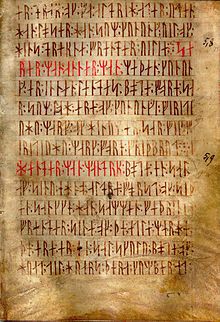
The runes developed centuries after the Mediterranean alphabets from which they are potentially descended. There are some similarities to alphabets of Phoenician origin (Latin, Greek, Italic) that cannot possibly all be due to chance; an Old Italic alphabet, more particularly the Raetic alphabet of Bolzano, is often advanced as a candidate for the origin of the runes, with only five Elder Futhark runes ( ᛖ e, ᛇ ï, ᛃ j, ᛜ ŋ, ᛈ p) having no counterpart in the Bolzano alphabet (Mees 2000). This hypothesis is often denied by Scandinavian scholars, who usually favour a Latin origin for most or all of the runic letters (Odenstedt 1990; Williams 1996).[7] An Old Italic or "North Etruscan" thesis is supported by the inscription on the Negau helmet dating to the 2nd century BC (Markey 2001). This is in a northern Etruscan alphabet, but features a Germanic name, Harigast. New archaeological evidence came from Monte Calvario (Auronzo di Cadore).
The angular shapes of the runes are shared with most contemporary alphabets of the period used for carving in wood or stone. A peculiarity of the runic alphabet as compared to the Old Italic family is rather the absence of horizontal strokes. Runes were commonly carved on the edge of narrow pieces of wood. The primary grooves cut spanned the whole piece vertically, against the grain of the wood: curves are difficult to make, and horizontal lines get lost among the grain of the split wood. This vertical characteristic is also shared by other alphabets, such as the early form of the Latin alphabet used for the Duenos inscription.
The "West Germanic hypothesis" speculates on an introduction by West Germanic tribes. This hypothesis is based on claiming that the earliest inscriptions of around 200 AD, found in bogs and graves around Jutland (the Vimose inscriptions), exhibit word endings that, being interpreted by Scandinavian scholars to be Proto-Norse, are considered unresolved and having been long the subject of discussion. Inscriptions like wagnija, niþijo, and harija are supposed to incarnate tribenames, tentatively proposed to be Vangiones, the Nidensis and the Harii, tribes located in the Rhineland.[8] Since names ending in -io reflect Germanic morphology representing the Latin ending -ius, and the suffix -inius was reflected by Germanic -inio-,[9] the question of the problematic ending -ijo in masculine Proto-Norse would be resolved by assuming Roman (Rhineland) influences, while "the awkward ending -a of laguþewa (cf. Syrett 1994:44f.) can be solved by accepting the fact that the name may indeed be West Germanic;"[10] however, it should be noted that in the early Runic period differences between Germanic languages are generally assumed to be minute. Another theory assumes a Northwest Germanic unity preceding the emergence of Proto-Norse proper from roughly the 5th century.[11] An alternative suggestion explaining the impossibility to classify the earliest inscriptions as either North or West Germanic is forwarded by È. A. Makaev, who assumes a "special runic koine", an early "literary Germanic" employed by the entire Late Common Germanic linguistic community after the separation of Gothic (2nd to 5th centuries), while the spoken dialects may already have been more diverse.[12]
The formation of the Elder Futhark was complete by the early 5th century, with the Kylver Stone being the first evidence of the futhark ordering as well as of the p rune.
Runic divination
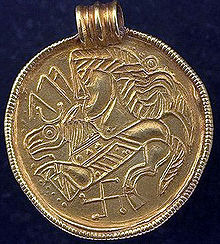


In stanza 157 of Hávamál, the runes are attributed with the power to bring that which is dead to life. In this stanza, Odin recounts a spell:
|
|
The earliest runic inscriptions found on artifacts give the name of either the craftsman or the proprietor, or, sometimes, remain a linguistic mystery. Due to this, it is possible that the early runes were not so much used as a simple writing system, but rather as magical signs to be used for charms. Although some say the runes were used for divination, there is no direct evidence to suggest they were ever used in this way. The name rune itself, taken to mean "secret, something hidden", seems to indicate that knowledge of the runes was originally considered esoteric, or restricted to an elite. The 6th century Björketorp Runestone warns in Proto-Norse using the word rune in both senses:
Haidzruno runu, falahak haidera, ginnarunaz. Arageu haeramalausz uti az. Weladaude, sa'z þat barutz. Uþarba spa.
I, master of the runes(?) conceal here runes of power. Incessantly (plagued by) maleficence, (doomed to) insidious death (is) he who breaks this (monument). I prophesy destruction / prophecy of destruction.[15]
The same curse and use of the word rune is also found on the Stentoften Runestone. There are also some inscriptions suggesting a medieval belief in the magical significance of runes, such as the Franks Casket (700 AD) panel.
Charm words, such as auja, laþu, laukaR and most commonly, alu,[16] appear on a number of Migration period Elder Futhark inscriptions as well as variants and abbreviations of them. Much speculation and study has been produced on the potential meaning of these inscriptions. Rhyming groups appear on some early bracteates that may also be magic in purpose, such as salusalu and luwatuwa. Further, an inscription on the Gummarp Runestone (500 to 700 AD) gives a cryptic inscription describing the use of three staves (runic letters) followed by the Elder Futhark f-rune written three times in succession.[17]
Nevertheless, it has proven difficult to find unambiguous traces of runic "oracles": Although Norse literature is full of references to runes, it nowhere contains specific instructions on divination. There are at least three sources on divination with rather vague descriptions that may or may not refer to runes: Tacitus's 1st century Germania, Snorri Sturluson's 13th century Ynglinga saga and Rimbert's 9th century Vita Ansgari.
The first source, Tacitus's Germania, describes "signs" chosen in groups of three and cut from "a nut-bearing tree," although the runes do not seem to have been in use at the time of Tacitus' writings. A second source is the Ynglinga saga, where Granmar, the king of Södermanland, goes to Uppsala for the blót. There, the "chips" fell in a way that said that he would not live long (Féll honum þá svo spánn sem hann mundi eigi lengi lifa). These "chips," however, are easily explainable as a blótspánn (sacrificial chip), which was "marked, possibly with sacrificial blood, shaken and thrown down like dice, and their positive or negative significance then decided."[18]
The third source is Rimbert's Vita Ansgari, where there are three accounts of what some believe to be the use of runes for divination, but Rimbert calls it "drawing lots". One of these accounts is the description of how a renegade Swedish king Anund Uppsale first brings a Danish fleet to Birka, but then changes his mind and asks the Danes to "draw lots". According to the story, this "drawing of lots" was quite informative, telling them that attacking Birka would bring bad luck and that they should attack a Slavic town instead. The tool in the "drawing of lots," however, is easily explainable as a hlautlein (lot-twig), which according to Foote and Wilson[18] would be used in the same manner as a blótspánn.
The lack of extensive knowledge on historical usage of the runes has not stopped modern authors from extrapolating entire systems of divination from what few specifics exist, usually loosely based on the runes' reconstructed names and additional outside influence.
A recent study of runic magic suggests that runes were used to create magical objects such as amulets (MacLeod and Mees 2006), but not in a way that would indicate that runic writing was any more inherently magical than were other writing systems such as Latin or Greek.
Common use
Some later runic finds are on monuments (runestones), which often contain solemn inscriptions about people who died or performed great deeds. For a long time it was assumed that this kind of grand inscription was the primary use of runes, and that their use was associated with a certain societal class of rune carvers.
In the mid-1950s, however, about 600 inscriptions known as the Bryggen inscriptions were found in Bergen. These inscriptions were made on wood and bone, often in the shape of sticks of various sizes, and contained inscriptions of an everyday nature—ranging from name tags, prayers (often in Latin), personal messages, business letters and expressions of affection to bawdy phrases of a profane and sometimes even vulgar nature. Following this find, it is nowadays commonly assumed that at least in late use, Runic was a widespread and common writing system.
In the later Middle Ages, runes were also used in the Clog almanacs (sometimes called Runic staff, Prim or Scandinavian calendar) of Sweden. The authenticity of some monuments bearing Runic inscriptions found in Northern America is disputed, but most of them date from modern times.
Gothic runes

Theories of the existence of separate Gothic runes have been advanced, even identifying them as the original alphabet from which the Futhark were derived, but these have little support in actual findings (mainly the spearhead of Kovel, with its right-to-left inscription, its T-shaped tiwaz and its rectangular dagaz). If there ever were genuinely Gothic runes, they were soon replaced by the Gothic alphabet. The letters of the Gothic alphabet, however, as given by the Alcuin manuscript (9th century), are obviously related to the names of the Futhark. The names are clearly Gothic, but it is impossible to say whether they are as old as, or even older than, the letters themselves. A handful of Elder Futhark inscriptions were found in Gothic territory, such as the 3rd to fifth century Ring of Pietroassa.
Later development
As Proto-Germanic evolved into its later language groups, the words assigned to the runes and the sounds represented by the runes themselves began to diverge somewhat, and each culture would either create new runes, rename or rearrange its rune names slightly, or even stop using obsolete runes completely, to accommodate these changes. Thus, the Anglo-Saxon futhorc has several runes peculiar to itself to represent diphthongs unique to (or at least prevalent in) the Anglo-Saxon dialect.
Nevertheless, the fact that the Younger Futhark has 16 runes, while the Elder Futhark has 24, is not fully explained by the some 600 years of sound changes that had occurred in the North Germanic language group. The development here might seem rather astonishing, since the younger form of the alphabet came to use fewer different rune signs at the same time as the development of the language led to a greater number of different phonemes than had been present at the time of the older futhark. For example, voiced and unvoiced consonants merged in script, and so did many vowels, while the number of vowels in the spoken language increased. From about 1100, this disadvantage was eliminated in the medieval runes, which again increased the number of different signs to correspond with the number of phonemes in the language.
Body of runic inscriptions

The largest group of surviving Runic inscription are Viking Age Younger Futhark runestones, most commonly found in Sweden. Another large group are medieval runes, most commonly found on small objects, often wooden sticks. The largest concentration of runic inscriptions are the Bryggen inscriptions found in Bergen, more than 650 in total. Elder Futhark inscriptions number around 350, about 260 of which are from Scandinavia, of which about half are on bracteates. Anglo-Saxon futhorc inscriptions number around 100 items.
The following table lists the number of known inscriptions (in any alphabet variant) by geographical region:[citation needed]
| Area | Number of runic inscriptions |
|---|---|
| Sweden | 3,432 |
| Norway | 1,552 |
| Denmark | 844 |
| Scandinavian total | 5,826 |
| Continental Europe except Scandinavia and Frisia | 80 |
| Frisia | 20 |
| The British Isles except Ireland | > 200 |
| Greenland | > 100 |
| Iceland | < 100 |
| Ireland | 16 |
| Faroes | 9 |
| Non-Scandinavian total | > 500 |
| Total | > 6,400 |
Elder Futhark
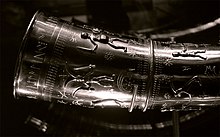
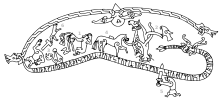
The Elder Futhark, used for writing Proto-Norse, consists of 24 runes that are often arranged in three groups of eight; each group is referred to as an Ætt. The earliest known sequential listing of the full set of 24 runes dates to around 400 AD and is found on the Kylver Stone in Gotland, Sweden.
Each rune most probably had a name, chosen to represent the sound of the rune itself. The names are, however, not directly attested for the Elder Futhark themselves. Reconstructed names in Proto-Germanic have been produced, based on the names given for the runes in the later alphabets attested in the rune poems and the linked names of the letters of the Gothic alphabet. The asterisk before the rune names means that they are unattested reconstructions. The 24 Elder Futhark runes are:[19]
| Rune | UCS | Trans. | IPA | Proto-Germanic name | Meaning |
|---|---|---|---|---|---|
| ᚠ | f | /ɸ/, /f/ | *fehu | "chattel, wealth" | |
| ᚢ | u | /u(ː)/ | ?*ūruz | "aurochs", Wild ox (or *ûram "water/slag"?) | |
| ᚦ | þ | /θ/, /ð/ | ?*þurisaz | "Thurs" (see Jötunn) or *þunraz ("the god Thunraz") | |
| ᚨ | a | /a(ː)/ | *ansuz | "god" | |
| ᚱ | r | /r/ | *raidō | "ride, journey" | |
| ᚲ | k (c) | /k/ | ?*kaunan | "ulcer"? (or *kenaz "torch"?) | |
| ᚷ | g | /ɡ/ | *gebō | "gift" | |
| ᚹ | w | /w/ | *wunjō | "joy" | |
| ᚺ ᚻ | h | /h/ | *hagalaz | "hail" (the precipitation) | |
| ᚾ | n | /n/ | *naudiz | "need" | |
| ᛁ | i | /i(ː)/ | *īsaz | "ice" | |
| ᛃ | j | /j/ | *jēra- | "year, good year, harvest" | |
| ᛇ | ï (æ) | /æː/[20] | *ī(h)waz | "yew-tree" | |
| ᛈ | p | /p/ | ?*perþ- | meaning unknown; possibly "pear-tree". | |
| ᛉ | z | /z/ | ?*algiz | "elk" (or "protection, defence"[21]) | |
| ᛊ ᛋ | s | /s/ | *sōwilō | "sun" | |
| ᛏ | t | /t/ | *tīwaz | "the god Tiwaz" | |
| ᛒ | b | /b/ | *berkanan | "birch" | |
| ᛖ | e | /e(ː)/ | *ehwaz | "horse" | |
| ᛗ | m | /m/ | *mannaz | "man" | |
| ᛚ | l | /l/ | *laguz | "water, lake" (or possibly *laukaz "leek") | |
| ᛜ | ŋ | /ŋ/ | *ingwaz | "the god Ingwaz" | |
| ᛞ | d | /d/ | *dagaz | "day" | |
| ᛟ | o | /o(ː)/ | *ōþila-/*ōþala- | "heritage, estate, possession" |
Frisian and Anglo-Saxon runes
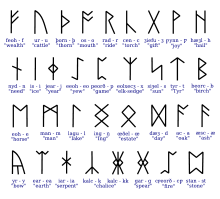
The futhorc are an extended alphabet, consisting of 29, and later even 33 characters. It was used probably from the 5th century onward. There are competing theories as to the origins of the Anglo-Saxon Fuþorc. One theory proposes that it was developed in Frisia and later spread to England. Another holds that runes were introduced by Scandinavians to England where the fuþorc was modified and exported to Frisia. Both theories have their inherent weaknesses and a definitive answer likely awaits more archaeological evidence. Futhorc inscriptions are found e.g. on the Thames scramasax, in the Vienna Codex, in Cotton Otho B.x (Anglo-Saxon rune poem) and on the Ruthwell Cross.
The Anglo-Saxon rune poem gives the following characters and names: ᚠ feoh, ᚢ ur, ᚦ thorn, ᚩ os, ᚱ rad, ᚳ cen, ᚷ gyfu, ᚹ wynn, ᚻ haegl, ᚾ nyd, ᛁ is, ᛄ ger, ᛇ eoh, ᛈ peordh, ᛉ eolh, ᛋ sigel, ᛏ tir, ᛒ beorc, ᛖ eh, ᛗ mann, ᛚ lagu, ᛝ ing, ᛟ ethel, ᛞ daeg, ᚪ ac, ᚫ aesc, ᚣ yr, ᛡ ior, ᛠ ear.
The expanded alphabet features the additional letters ᛢ cweorth, ᛣ calc, ᛤ cealc and ᛥ stan- these additional letters have only been found in manuscripts. Feoh, þorn, and sigel stood for [f], [þ], and [s] in most environments, but voiced to [v], [ð], and [z] between vowels or voiced consonants. Gyfu and wynn stood for the letters yogh and wynn, which became [g] and [w] in Middle English.
Younger Fuþark

The Younger Fuþark, also called Scandinavian Fuþark, is a reduced form of the Elder Futhark, consisting of only 16 characters. The reduction correlates with phonetic changes when Proto-Norse evolved into Old Norse. They are found in Scandinavia and Viking Age settlements abroad, probably in use from the 9th century onward. They are divided into long-branch (Danish) and short-twig (Swedish and Norwegian) runes. The difference between the two versions has been a matter of controversy. A general opinion is that the difference was functional; i.e. the long-branch runes were used for documentation on stone, whereas the short-branch runes were in everyday use for private or official messages on wood.
"Marcomannic runes"
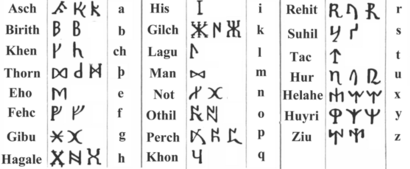
In a treatise called De Inventione Litterarum, preserved in 8th and 9th century manuscripts, mainly from the southern part of the Carolingian Empire (Alemannia, Bavaria), ascribed to Hrabanus Maurus, a runic alphabet consisting of a curious mixture of Elder Futhark with Anglo-Saxon futhorc is recorded. The alphabet is traditionally called "Marcomannic runes", but it has no connection with the Marcomanni and is rather an attempt of Carolingian scholars to represent all letters of the Latin alphabets with runic equivalents.
Medieval runes

In the Middle Ages, the Younger Futhark in Scandinavia was expanded, so that it once more contained one sign for each phoneme of the Old Norse language. Dotted variants of voiceless signs were introduced to denote the corresponding voiced consonants, or vice versa, voiceless variants of voiced consonants, and several new runes also appeared for vowel sounds. Inscriptions in medieval Scandinavian runes show a large number of variant rune forms, and some letters, such as s, c and z, were often used interchangeably.[22][23]
Medieval runes were in use until the 15th century. Of the total number of Norwegian runic inscriptions preserved today, most are medieval runes. Notably, more than 600 inscriptions using these runes have been discovered in Bergen since the 1950s, mostly on wooden sticks (the so-called Bryggen inscriptions). This indicates that runes were in common use side by side with the Latin alphabet for several centuries. Indeed, some of the medieval runic inscriptions are actually in Latin language.
Dalecarlian runes

According to Carl-Gustav Werner, "In the isolated province of Dalarna in Sweden a mix of runes and Latin letters developed."(Werner 2004, p. 7) The Dalecarlian runes came into use in the early 16th century and remained in some use up to the 20th century. Some discussion remains on whether their use was an unbroken tradition throughout this period or whether people in the 19th and 20th centuries learned runes from books written on the subject. The character inventory was mainly used for transcribing Elfdalian.
Runology
Runology is the study of the Runic alphabets, Runic inscriptions and their history. Runology forms a specialized branch of Germanic linguistics.
Modern use
Runic alphabets have seen numerous usages in modern use, usually in association with or referencing Germanic paganism.
Occultism and Nazi Germany
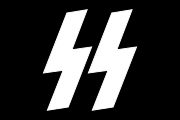
The pioneer of the Armanist branch of Ariosophy and one of the more important figures in esotericism in Germany and Austria in the late 19th and early 20th century was the Austrian occultist, mysticist and völkisch author Guido von List. In 1908, he published in Das Geheimnis der Runen ("The Secret of the Runes") a set of 18 so-called "Armanen runes", based on the Younger Futhark and runes of List's own introduction, which were allegedly revealed to him in a state of temporary blindness after a cataract operation on both eyes in 1902.
Runes have been used in Nazi symbolism by Nazis and Neo-Nazi groups that associate themselves with Germanic traditions, mainly the Sig, Eihwaz, Tiwaz, Odal and Algiz runes.
The fascination that runes seem to have exerted on the Nazis can be traced to Guido von List. His rune row, however, was later rejected by the Nazis in favor of the Wiligut runes created by the official Nazi Runologist Karl Maria Wiligut.
In Nazi contexts, the s rune is referred to as "Sig" (after List, probably from Anglo-Saxon Sigel). The "Wolfsangel", while not a rune historically, has the shape of List's "Gibor" rune; however, it should be noted that the shape of the Armanen rune "Gibor", as envisaged by Von List, is substantially different from the form currently used. Who exactly it is that changed the shape of Gibor is open to debate, but it appeared in its "new form" in the early 1930s. Nevertheless, if one examines Von List's original documents, one will find a somewhat different design, one that bears little resemblance to the "Wolfsangel".
Another modern-day runic row is the Uthark, commonly known through the work of the Swedish scholar and occultist Thomas Karlsson, founder of the Ordo Draconis et Atri Adamantis (or Dragon Rouge), who refers to them as the "night side of the runes". This runic row and theory had however been the subject of an earlier study by the Swedish philologist Sigurd Agrell.
J. R. R. Tolkien
In J. R. R. Tolkien's novel The Hobbit, the Anglo-Saxon runes are used on a map to emphasize its connection to the Dwarves. They were also used in the initial drafts of The Lord of the Rings, but later were replaced by the Cirth rune-like alphabet invented by Tolkien.
Neopaganism and New Age
As forms of Neopaganism can be quite different and have distinctive origins, recognition and usage of runes can vary considerably.
As with Germanic paganism in general, the runes are a major element in Germanic neopaganism used for a wide variety of purposes in varying senses of reconstructionism, depending on the type of group. The more academic adherents of Germanic neopaganism eschew any use of runes outside of writing and magic.
New Agers and some Wiccans may also sometimes use runes under various (generally non-reconstructive) conditions, such as divination.
Modern popular culture
Historical and fictional runes appear commonly in modern popular culture, particularly in fantasy literature, video games, and various other forms of media. Runes also appear frequently in video games, such as RuneScape, Diablo II: Lord of Destruction and Kameo.
Unicode
Runic alphabets are assigned Unicode range 16A0–16FF. This block is intended to encode all shapes of runic letters. Each letter is encoded only once, regardless of the number of alphabets in which it occurs.
The block contains 81 symbols: 75 runic letters (16A0–16EA), three punctuation marks (Runic Single Punctuation 16EB ᛫, Runic Multiple Punctuation 16EC ᛬ and Runic Cross Punctuation 16ED ᛭), and three runic symbols that are used in mediaeval calendar staves ("Golden number Runes", Runic Arlaug Symbol 16EE ᛮ, Runic Tvimadur Symbol 16EF ᛯ and Runic Belgthor Symbol 16F0 ᛰ). Characters 16F1–16FF are unassigned (as of Unicode Version 5.0).
Unicode fonts that support the runic range include the following Free Unicode fonts; Junicode, Free Mono, and Caslon Roman and the following non-free Unicode fonts; Code2000, Everson Mono, and TITUS Cyberbit Basic.
Table of runic letters (U+16A0–U+16EA):
| 16A0 | ᚠ | fehu feoh fe f | 16B0 | ᚰ | on | 16C0 | ᛀ | dotted-n | 16D0 | ᛐ | short-twig-tyr t | 16E0 | ᛠ | ear |
| 16A1 | ᚡ | v | 16B1 | ᚱ | raido rad reid r | 16C1 | ᛁ | isaz is iss i | 16D1 | ᛑ | d | 16E1 | ᛡ | ior |
| 16A2 | ᚢ | uruz ur u | 16B2 | ᚲ | kauna | 16C2 | ᛂ | e | 16D2 | ᛒ | berkanan beorc bjarkan b | 16E2 | ᛢ | cweorth |
| 16A3 | ᚣ | yr | 16B3 | ᚳ | cen | 16C3 | ᛃ | jeran j | 16D3 | ᛓ | short-twig-bjarkan b | 16E3 | ᛣ | calc |
| 16A4 | ᚤ | y | 16B4 | ᚴ | kaun k | 16C4 | ᛄ | ger | 16D4 | ᛔ | dotted-p | 16E4 | ᛤ | cealc |
| 16A5 | ᚥ | w | 16B5 | ᚵ | g | 16C5 | ᛅ | long-branch-ar ae | 16D5 | ᛕ | open-p | 16E5 | ᛥ | stan |
| 16A6 | ᚦ | thurisaz thurs thorn | 16B6 | ᚶ | eng | 16C6 | ᛆ | short-twig-ar a | 16D6 | ᛖ | ehwaz eh e | 16E6 | ᛦ | long-branch-yr |
| 16A7 | ᚧ | eth | 16B7 | ᚷ | gebo gyfu g | 16C7 | ᛇ | iwaz eoh | 16D7 | ᛗ | mannaz man m | 16E7 | ᛧ | short-twig-yr |
| 16A8 | ᚨ | ansuz a | 16B8 | ᚸ | gar | 16C8 | ᛈ | pertho peorth p | 16D8 | ᛘ | long-branch-madr m | 16E8 | ᛨ | Icelandic-yr |
| 16A9 | ᚩ | os o | 16B9 | ᚹ | wunjo wynn w | 16C9 | ᛉ | algiz eolhx | 16D9 | ᛙ | short-twig-madr m | 16E9 | ᛩ | q |
| 16AA | ᚪ | ac a | 16BA | ᚺ | haglaz h | 16CA | ᛊ | sowilo s | 16DA | ᛚ | laukaz lagu logr l | 16EA | ᛪ | x |
| 16AB | ᚫ | aesc | 16BB | ᚻ | haegl h | 16CB | ᛋ | sigel long-branch-sol s | 16DB | ᛛ | dotted-l | 16EB | ᛫ | single punctuation |
| 16AC | ᚬ | long-branch-oss o | 16BC | ᚼ | long-branch-hagall h | 16CC | ᛌ | short-twig-sol s | 16DC | ᛜ | ingwaz | 16EC | ᛬ | multiple punctuation |
| 16AD | ᚭ | short-twig-oss o | 16BD | ᚽ | short-twig-hagall h | 16CD | ᛍ | c | 16DD | ᛝ | ing | 16ED | ᛭ | cross punctuation |
| 16AE | ᚮ | o | 16BE | ᚾ | naudiz nyd naud n | 16CE | ᛎ | z | 16DE | ᛞ | dagaz daeg d | 16EE | ᛮ | arlaug symbol |
| 16AF | ᚯ | oe | 16BF | ᚿ | short-twig-naud n | 16CF | ᛏ | tiwaz tir tyr t | 16DF | ᛟ | othalan ethel o | 16EF | ᛯ | tvimadur symbol |
| 16F0 | ᛰ | belgthor symbol |
| Runic[1][2] Official Unicode Consortium code chart (PDF) | ||||||||||||||||
| 0 | 1 | 2 | 3 | 4 | 5 | 6 | 7 | 8 | 9 | A | B | C | D | E | F | |
| U+16Ax | ᚠ | ᚡ | ᚢ | ᚣ | ᚤ | ᚥ | ᚦ | ᚧ | ᚨ | ᚩ | ᚪ | ᚫ | ᚬ | ᚭ | ᚮ | ᚯ |
| U+16Bx | ᚰ | ᚱ | ᚲ | ᚳ | ᚴ | ᚵ | ᚶ | ᚷ | ᚸ | ᚹ | ᚺ | ᚻ | ᚼ | ᚽ | ᚾ | ᚿ |
| U+16Cx | ᛀ | ᛁ | ᛂ | ᛃ | ᛄ | ᛅ | ᛆ | ᛇ | ᛈ | ᛉ | ᛊ | ᛋ | ᛌ | ᛍ | ᛎ | ᛏ |
| U+16Dx | ᛐ | ᛑ | ᛒ | ᛓ | ᛔ | ᛕ | ᛖ | ᛗ | ᛘ | ᛙ | ᛚ | ᛛ | ᛜ | ᛝ | ᛞ | ᛟ |
| U+16Ex | ᛠ | ᛡ | ᛢ | ᛣ | ᛤ | ᛥ | ᛦ | ᛧ | ᛨ | ᛩ | ᛪ | ᛫ | ᛬ | ᛭ | ᛮ | ᛯ |
| U+16Fx | ᛰ | ᛱ | ᛲ | ᛳ | ᛴ | ᛵ | ᛶ | ᛷ | ᛸ | |||||||
| Notes | ||||||||||||||||
See also
- Runamo – a false runic inscription
- Erilaz
- Solomon and Saturn
- Codex Runicus
- Computus Runicus
- Rundata
Other scripts, reminiscent of, based on or related to runes:
- Old Italic alphabet
- Ogham, the early Irish monumental alphabet
- the "Armanen runes", invented by Guido von List
- the Cirth "runes", invented by J. R. R. Tolkien
- Orkhon script and Old Hungarian script (sometimes referred to as Turkic and Hungarian runes)
- Slavic runes (unattested sign system postulated from medieval accounts)
- Siglas Poveiras
Notes
- ^ Stoklund (2003:173)
- ^ Entry Vg 63 in Rundata 2.0 for Windows.
- ^ Entry Vg 119 in Rundata 2.0 for Windows.
- ^ Hávamál at «Norrøne Tekster og Kvad», Norway.
- ^ Larrington, Carolyne. (Trans.) (1999) The Poetic Edda, page 25. Oxford World's Classics ISBN 0192839462
- ^ a b Larrington, Carolyne. (Trans.) (1999) The Poetic Edda, page 34. Oxford World's Classics ISBN 0192839462
- ^ Cf. Oxford Dictionary of the Middle Ages (book under preparation)
- ^ Looijenga, J. H. (1997). Runes around the North Sea and on the Continent 150-700CE, dissertation, Groningen University.
- ^ Weisgerber 1968:135, 392ff. and Weisgerber 1966/67:207
- ^ Looijenga, J. H. (1997). Runes around the North Sea and on the Continent AD 150-700, dissertation, Groningen University.
- ^ Penzl (1994) assumes a period of "Proto-Nordic-Westgermanic" unity down to the 5th century and the Gallehus horns inscription. H. Penzl, Language (1994), p. 186; in greater detail in Englisch: Eine Sprachgeschichte nach Texten von 350 bis 1992 : vom Nordisch-Westgermanischen zum Neuenglischen (1994); the division between Northwest Germanic and Proto-Norse is somewhat arbitrary, see Elmer H. Antonsen, On Defining Stages in Prehistoric Germanic, Language (1965), p. 36
- ^ cited after . Antonsen (1965), p. 36
- ^ Hávamál
- ^ Larrington, Carolyne. (Trans.) (1999) The Poetic Edda, page 37. Oxford World's Classics ISBN 0192839462
- ^ Entry DR 360 in Rundata 2.0 for Windows.
- ^ Macleod, Mindy. Mees, Bernard. (2006) Runic Amulets and Magic Objects, page 100 to 101. Boydell Press ISBN 1843832054
- ^ Page, R.I. (2005) Runes, page 31. The British Museum Press ISBN 0-7141-8065-3
- ^ a b Foote, P.G., and Wilson, D.M. (1970). The Viking Achievement, Sidgwick & Jackson: London, UK, ISBN 0-283-97926-7 Cite error: The named reference "PAGE401" was defined multiple times with different content (see the help page).
- ^ Page, R.I. (2005) Runes, pages 8, 15, and 16. The British Museum Press ISBN 0-7141-8065-3
- ^ also rendered /ɛː/, see Proto-Germanic phonology.
- ^ Ralph Warren, Victor Elliott, Runes: an introduction, Manchester University Press ND, 1980, 51-53.
- ^ Jacobsen & Moltke, 1941–42, p. VII
- ^ Werner, 2004, p. 20
References
- Bammesberger, A and G. Waxenberger (eds), Das fuþark und seine einzelsprachlichen Weiterentwicklungen, Walter de Gruyter (2006), ISBN 3-11-019008-7.
- Blum, Ralph. (1932. The Book of Runes - A Handbook for the use of Ancient Oracle : The Viking Runes,Oracle Books, St. Martin's Press, New York, ISBN 0-312-00729-9.
- Brate, Erik (1922). Sveriges runinskrifter, (online text in Swedish)
- Düwel, Klaus (2001). Runenkunde, Verlag J.B. Metzler (In German).
- Jacobsen, Lis (1941–42). Danmarks runeindskrifter. Copenhagen: Ejnar Munksgaards Forlag.
{{cite book}}: Unknown parameter|coauthors=ignored (|author=suggested) (help) - Foote, P.G., and Wilson, D.M. (1970), page 401. The Viking Achievement, Sidgwick & Jackson: London, UK, ISBN 0-283-97926-7
- Looijenga, J. H. (1997). Runes around the North Sea and on the Continent AD 150-700, dissertation, Groningen University.
- MacLeod, Mindy, and Bernard Mees (2006). Runic Amulets and Magic Objects" . The Boydell Press: Woodbridge, UK; Rochester, NY, ISBN 1843832054.
- Markey, T.L. (2001). A tale of the two helmets: Negau A and B. Journal of Indo-European Studies 29: 69-172.
- McKinnell, John and Rudolf Simek, with Klaus Düwel (2004). Runes, Magic, and Religion: A Sourcebook. Wien: Fassbaender, ISBN 3900538816.
- Mees, Bernard (200). The North Etruscan thesis of the origin of the runes. Arkiv for nordisk fililogi 115: 33-82.
- Odenstedt, Bengt (1990). On the Origin and Early History of the Runic Script, Uppsala, ISBN 9185352209.
- Page, R.I. (1999). An Introduction to English Runes, The Boydell Press, Woodbridge. ISBN 0-85115-946-X.
- Prosdocimi, A.L. (2003-4). Sulla formazione dell'alfabeto runico. Promessa di novità documentali forse decisive. Archivio per l'Alto Adige. XCVII-XCVIII:427-440
- Robinson, Orrin W. (1992). Old English and its Closest Relatives: A Survey of the Earliest Germanic Languages Stanford University Press. ISBN 0-8047-1454-1
- Spurkland, Terje (2005). Norwegian Runes and Runic Inscriptions", Boydell Press. ISBN 1-84383-186-4
- Stoklund, M. (2003). The first runes - the literary language of the Germani in The Spoils of Victory - the North in the Shadow of the Roman Empire Nationalmuseet (?)
- Werner, Carl-Gustav (2004). The allrunes Font and PackageTemplate:PDFlink.
- Williams, Henrik. (1996). The origin of the runes. Amsterdamer Beiträge zur älteren Germanistik' 45: 211-18.
- Williams, Henrik (2004). "Reasons for runes," in The First Writing: Script Invention as History and Process, Cambridge University Press, pp. 262-273. ISBN 0-521-83861-4
External links
- Ancientscripts.com Futhark entry.
- Omniglot.com runic alphabet entry.
- Nytt om Runer Magazine.
- Bibliography of Runic Scholarship
- The Viking Rune
